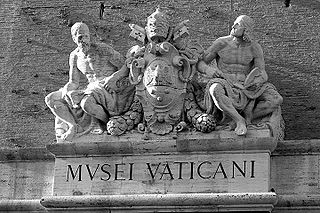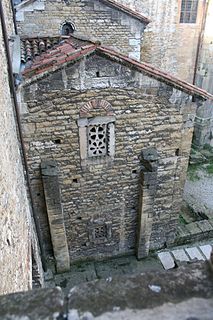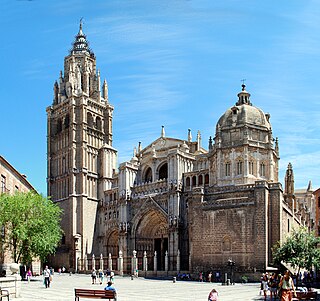
Alfonso VI, nicknamed the Brave or the Valiant, was king of León (1065–72) and of Galicia, and then king of the reunited Castile and León.
Alfonso VIII, called the Noble or the one of the Navas, was the King of Castile from 1158 to his death and King of Toledo. He is most remembered for his part in the Reconquista and the downfall of the Almohad Caliphate. After having suffered a great defeat with his own army at Alarcos against the Almohads in 1195, he led the coalition of Christian princes and foreign crusaders who broke the power of the Almohads in the Battle of Las Navas de Tolosa in 1212, an event which marked the arrival of a tide of Christian supremacy on the Iberian peninsula.

The Vatican Museums are Christian and art museums located within the city boundaries of the Vatican City. They display works from the immense collection amassed by popes throughout the centuries including several of the most renowned Roman sculptures and most important masterpieces of Renaissance art in the world. The museums contain roughly 70,000 works, of which 20,000 are on display, and currently employ 640 people who work in 40 different administrative, scholarly, and restoration departments.

Palencia is a city south of Tierra de Campos, in north-northwest Spain, the capital of the province of Palencia in the autonomous community of Castile and León. The municipality had a population of 78,892 in 2017.

The Metropolitan Cathedral Basilica of the Holy Saviour or Cathedral of San Salvador is a Roman Catholic church and minor basilica in the centre of Oviedo, in the Asturias region of northern Spain.

The Synagogue of Santa María la Blanca is a museum and former synagogue in Toledo, Spain. Erected in 1180, according to an inscription on a beam, it is disputably considered the oldest synagogue building in Europe still standing. It is now owned and preserved by the Catholic Church.

Bolaños de Calatrava is a city situated in the Ciudad Real province in the autonomous community of Castile-La Mancha, Spain. It is 4 kilometers from Almagro.

Elisabeth of Swabia, was a German princess member of the House of Hohenstaufen and by marriage Queen consort of Castile and Leon.

The Palacio de Galiana is a Mudéjar palace in Toledo, Spain, on the borders of the Tagus River. It was built on the site of an earlier summer villa and garden of Al-Mamun, the king of the Taifa of Toledo, in the thirteenth century by king Alfonso X of Castile.

The Mezquita de las Tornerías is a Moorish former mosque in Toledo. It was built in the middle of the 11th century, built on a foundations of Roman architecture, located in the old Muslim neighborhood Arrabal de Francos. Currently it houses the "Center Foundation of Promotion of the Crafts", that can be visited and attend temporary exhibitions. The building continued maintaining the Islam in Spain, even well beyond the reconquista of the city by the Christian troops of Alfonso VI of León and Castile in 1085, until the period of 1498 - 1505 when was desacralizated by the Catholic Monarchs. Already as a building for civil use, it goes through various vicissitudes, first as an inn in 1505 and then as the headquarters of different businesses and small factories or as a simple home. Its history is lost until the late 19th century, where historians investigate its origins didn't know if it was a synagogue or a mosque. After the studies, the 15 March 1905 was officially communicated to the Real Academia de la Historia the finding of an Arab mosque in the street of the Tornerías.

The Mezquita-Iglesia de El Salvador is a church in Toledo, Spain completed in 1159.

The Iglesia de San Román is a church in Toledo. The church was built in the Mudéjar style in the 13th century. In this site there was an old Visigothic structure and probably an ancient Roman building. It is currently the headquarters of the Museum of the Councils and Visigothic Culture.

The Church of Saint Thyrsus is a Roman Catholic Asturian Romanesque church situated in Oviedo, in Asturias, northern Spain. The church was established in the 790s. Dedicated to Saint Thyrsus, it was built by Tioda, the royal architect of Alfonso II of Asturias. The Great Fire of Oviedo in 1521 and rebuilding in the 18th century removed most of the original church, except for a three-light window.

The Holy chamber of Oviedo is a Roman Catholic pre-Romanesque church in Oviedo, Spain, built next to pre-romanesque Tower of San Miguel of the city's cathedral. Nowadays, the church occupies the angle between the south arm of the cathedral transept and a side of the cloister.

The Puente de Alcántara is a Roman arch bridge in Toledo, Spain, spanning the Tagus River. The word Alcántara comes from Arabic القنطرة (al-qanţarah), which means "bridge".

The Primate Cathedral of Saint Mary of Toledo is a Roman Catholic church in Toledo, Spain. It is the seat of the Metropolitan Archdiocese of Toledo.

The Castle of Burgos was a castle and alcázar, located in the city of Burgos, in the hill of San Miguel to 75 m above the city and to 981 meters above the sea. This hill was the subject of archaeological surveys by General Centeno in the years 1925 and 1926 trying to find Napoleonic military files from when the French in their retreat blew up the fortress. According to the results obtained in this excavation the origin of the castle dates to the Visigoths, and its oldest parts, to the Romans.

The Convento de San Clemente is a Renaissance convent located in the city of Toledo, in Castile-La Mancha, Spain. It was founded in the 13th century during the reign of Alfonso X of Castile the Wise. Inside the building there are a Roman cistern, Mudéjar architecture, remains of the Palacio de los Cervatos and many decorative elements. It was rebuilt by Alonso de Covarrubias, and a cloister by José Ortega.
The Roman vaults of Nuncio Viejo are a Roman vaults located in Calle Nuncio Viejo street, in the city of Toledo, Castile-La Mancha, Spain




















